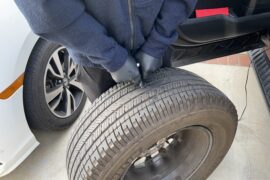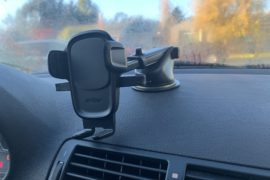When you make purchases through links on this site, The Track Ahead may earn an affiliate commission. Also, these posts are based off my own experiences. I am not responsible for any action you take as a result of reading this. Learn More
The term “dead battery” is a term used pretty loosely to describe a car battery that no longer has the ability to start your car. Typically a healthy battery will have a voltage reading of 12.6 Volts or higher. The lower the voltage, the less of a charge the battery has. Once you get down lower than 12.2 Volts, the battery will begin to have trouble supplying the required power to the starter motor to start the car.
It’s typical for a car battery’s voltage to drop down below 12 Volts if there is a parasitic drain (e.g. you left the car door open overnight and the cabin lights drain the battery), or if you simply haven’t started the car for a prolonged period of time. When these types of events happen, the voltage typically only drops down a few Volts, and a jump start will typically get the car started again. Driving the car afterwards will allow the alternator to recharge the battery to an adequate voltage yet again.
Other times, the battery has drained down so low that you end up in single-digit voltage, sometimes even with a reading of 0 Volts. In times like these, a jump start won’t be able to start your car. This is because portable jump starters have a built-in safety that won’t enable the jump starter if it doesn’t sense enough voltage on the battery to begin with.

Using a trickle charger alone will also not likely work. This is because trickle chargers only work if your car’s battery has sufficient voltage to begin with.


How to Recharge a Completely Dead Battery
There are a couple ways you can fully recharge your completely dead battery at home. If you have another car at home, you can use that battery to recharge your fully depleted battery using a set of jumper cables. The other way is using the override function on your portable jump starter to get the car started, and then to run the vehicle at high idle for at least 30 minutes to recharge the battery.
Recharging with Another Battery With a Set of Jumper Cables
Products used for this method:
Energizer 16-Gauge (16′ Long) Jumper Cables with Carrying Bag
Fluke 101 Basic Pocket Digital Multimeter
Battery Tender 4A Battery Charger and Maintainer – 12V or 6V
If you have another vehicle at home with a good battery, you can use this battery to bring your fully depleted battery back to full charge. If you can drive the car with the healthy battery all the way up to your dead car’s battery so that the jumper cables reach, then do so. Otherwise, you will have to remove the healthy car battery and bring it closer to the dead battery in order to connect the jumper cables.


A multimeter comes in handy to check the voltages on each of the batteries. On the healthy battery, I have a reading of 12.52 Volts, which is a good reading. On my fully depleted battery, I’m reading 1.784 Volts. After charging, I will check the readings again to confirm that the depleted battery is fully charged.


Take a set of jumper cables and connect the positive-to-positive and negative-to-negative between the good battery and bad battery. Ensure that you’re using an adequately-sized set of jumper cables (at least 6-gauge). Some jumper cables such as the ones that come in emergency kits are can be so thin that they can end up melting during use. Take a look at the connections and make sure there are no issues as you will be leaving it like this for at least 30 minutes.

You can check the voltage of the dead battery while it is charging; it will read good because it is connected to the healthy battery. However, it doesn’t mean it’s fully charged yet. If you disconnected the jumper cables, the voltage will go back to its normal low voltage. You need the dead battery connected to the good battery for at least an hour to fully charge.

After at least an hour of charging, disconnect the jumper cables. You can use a multimeter to verify that the completely dead battery is now at an adequate voltage. My dead battery was previously reading 1.784V, and after charging for an hour it is now at 12.07 Volts. It’s is good enough to get the car started but it’s still not fully charged.


Now would be a good time to put a trickle charger on the car to get it fully charged. Also simply driving the car would allow the alternator to fully recharge the battery back to full health.

Recharging Using the Override Feature on a Portable Jumper Starter
Products used for this method:
NOCO Boost Plus GB40 1000A Portable Jump Starter
Fluke 101 Basic Pocket Digital Multimeter
Battery Tender 4A Battery Charger and Maintainer – 12V or 6V
There is another way to recharge your battery if you don’t have a spare car battery availabl As I mentioned previously, portable jump starters typically have a safety feature built-in that won’t allow you to jump start your vehicle if it senses that the voltage on the battery is too low. The safety feature is there because it can be a safety risk for the portable jump starter to throw out the full 12+ Volts on its terminals, which is not required for the typical dead battery.
But with a completely dead battery, we do need the full voltage in order to get the battery re-charged adequately. Portable jump starters may or may not have a “boost” function that overrides the safety feature. If you press this “boost” or similar button on the jump starter, it will send the full 12 Volts to the cables.
If your battery is fully depleted, overriding the safety and trying to start the car right away may not result in sucessfully starting your car. Leave the “boost” feature on, and allow the jump starter to slowly re-charge the battery. Depending on your jump starter, it may shut off after a certain amount of time, so keep pressing the “boost” button to continue to charge for as long as you can.

After an adequate amount of charging time, the voltage will be high enough for the car to actually start. Now, if you started the car and left the car to idle, the voltage may not be sufficient to keep the car on at its normal idle. However, if you press down on the accelerator pedal, the engine RPM’s will increase and you will notice that this keeps the vehicle from sputtering out and dying. This is because at higher RPM’s, the alternator is working to re-charge the battery.
So using the “boost” on the jump starter will just get the car started, but you need to find a way to keep the idle high so the battery can be fully charged. If you can find something heavy to hold the accelerator down like a stone or paver, you can keep the idle high so that the battery gets recharged.. The idle doesn’t necessarily need to be very high, it typically just needs to be more than 1,000 RPM to effectively recharge the battery.

I would just like to caution you there can be a risk doing this method. This is because if the vehicle is accidentally put into drive with the accelerator down, it can be a big danger. Always be safe if using this method: make sure the vehicle is in Park if it’s an automatic or Neutral if it’s a manual, ensure the emergency brake is on, and chock the wheels as an added safety.
Leave the car to idle at greater than 1,000 RPM’s for at least 20-30 minutes. When this is completed, you’ll have a battery that is mostly recharged. At this time, a trickle charger or normal driving of the vehicle will recharge it the rest of the way.
My Experience with Recharging a Completely Dead Battery
I hope this information is helpful to you if you’ve experienced a completely dead battery. I’ve found myself in this situation several times over the years and these two methods have always worked for me. The best solution out of the two is to use another battery with jumper cables to recharge the completely dead battery. But if you don’t have another battery at your disposal, the second method is acceptable as well but requires a more attention during the process. Whichever method you go with, take all proper precautions and be safe.










